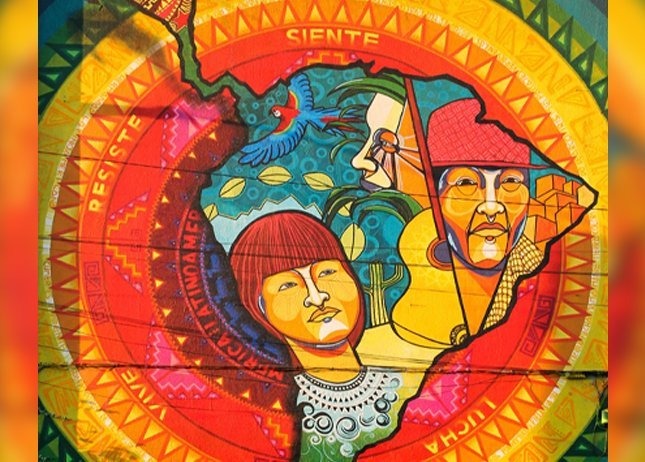The election of Lula in Brazil and Petro in Colombia in 2022 have led to increased noise in both the media and left-wing circles about a second ‘pink tide’ in Latin America. This is a reference to the wave of so-called ‘progressive’ governments that ruled for a number of years in several countries of the continent between 1998-2015. It is perhaps apt that these governments are described as a ‘pink’ tide, as they are certainly far from being socialist ‘red’. It is necessary to examine the character of that first wave, the reasons that allowed it to last as long as it did, why it came to an end, and the different conditions facing this new wave.
It is indeed the case that governments described by the bourgeois media as being, in one way or another, centre-left have been elected in Argentina (2019), Brazil (2022), Chile (2021), Colombia (2022), and Mexico (2018). These are five of Latin America’s largest countries. To these we could add the short-lived government of Pedro Castillo in Peru, Bolivia (2020), and Honduras (2021).
This is quite a turnaround from the openly right-wing governments of Macri (Argentina), Bolsonaro (Brasil), Peña Nieto (Mexico), Piñera (Chile) and the coup governments in Honduras and Bolivia. These are also the main countries constituting the ‘Lima group’, an ad hoc organisation created in 2017 to carry out regime change in Venezuela on behalf of US imperialism.
On the surface of it, this seems like quite a powerful array. Some, like Jacobin, in their enthusiasm for these governments have gone as far as to say that this new wave will be stronger than the first one. However, as we will explain, many of these governments are not left-wing at all; several include open representatives of the ruling class; and none of them has a clear programme for challenging capitalism.
But before we go into that, it is worth analysing the character of the first wave of ‘progressive governments’ and the reasons for their downfall.
The crisis of the 1980s
During the 1980s, Latin America went through what became known as ‘the lost decade’. The immediate causes of the crisis related to the world capitalist crisis of the late 1970s. The contraction of the world economy led to a collapse in the prices of oil and other raw materials, hitting Latin American economies that exported these commodities to the world market. Added to this was the raising of interest rates in advanced capitalist countries to fight runaway inflation that had developed during the 1970s. This made interest on Latin America’s foreign debt much more expensive.
This combination of factors produced a sharp economic contraction in the continent as a whole. GDP stagnated in 1981 (growing 0.8 percent), and contracted in 1982 (-0.3 percent) and 1983 (-1.9 percent). In per capita terms, GDP contracted by 9 percent between 1980 and 1985. By 1982, Mexico defaulted on its foreign debt, provoking a generalised debt crisis in the continent. Foreign lenders were not prepared to renegotiate and demanded their money back.
The only recourse they had was to the IMF, which intervened by demanding the implementation of brutal austerity packages, massive cuts in government spending and privatisation of state assets, all in the name of paying off foreign debt. Tens of millions were thrown into poverty while governments were forced to pay billions of dollars to imperialist creditors abroad.
The social and political consequences of the crisis were felt throughout the continent. They played a role in the end of military dictatorships in Chile, Argentina and Brazil, seriously weakened the rule of the PRI in Mexico and led to a massive popular uprising in Venezuela in 1989.
This was the beginning of what was known as ‘neoliberalism’. In reality, these were the policies imposed by imperialism and the local oligarchies in order to make the workers pay for the crisis of capitalism. This was compounded in the early 1990s by the process known as ‘globalisation’ – that is, the further exploitation of the world market by the imperialist powers.
Latin American countries were forced to ‘open up’ their economies, which meant their further penetration by foreign multinationals. The so-called free trade agreements in practice furthered the domination of these countries’ economies by imperialism. Trade protections were torn down; the state sector was privatised and opened up for investment by multinationals; what labour and environmental protections there were were abolished; private pension systems were established.
The countries that were forced furthest down this road were perhaps Chile (where the process was begun with the intervention of the ultra-monetarist ‘Chicago Boys’ under the Pinochet regime) and in Peru (particularly during the Fujimori dictatorship in the 1990s). Spanish multinationals played a key role in this process, taking over banks, telecommunications and gas. Mining multinationals from Britain, Canada and the US also benefited.
By the end of the 1990s, the full impact of these policies was clear for everyone to see. There was a massive increase in poverty and extreme poverty, the opening up of a huge gulf in inequality in income distribution, and ever-greater domination of these nations by the world capitalist market.
Mass uprisings
The stage was set for massive uprisings by workers and peasants, which quickly acquired insurrectionary characteristics. Already, in 1994, we saw the Zapatista uprising in Mexico, with its base amongst the poor peasants of Chiapas, but with widespread support and sympathy throughout the country.
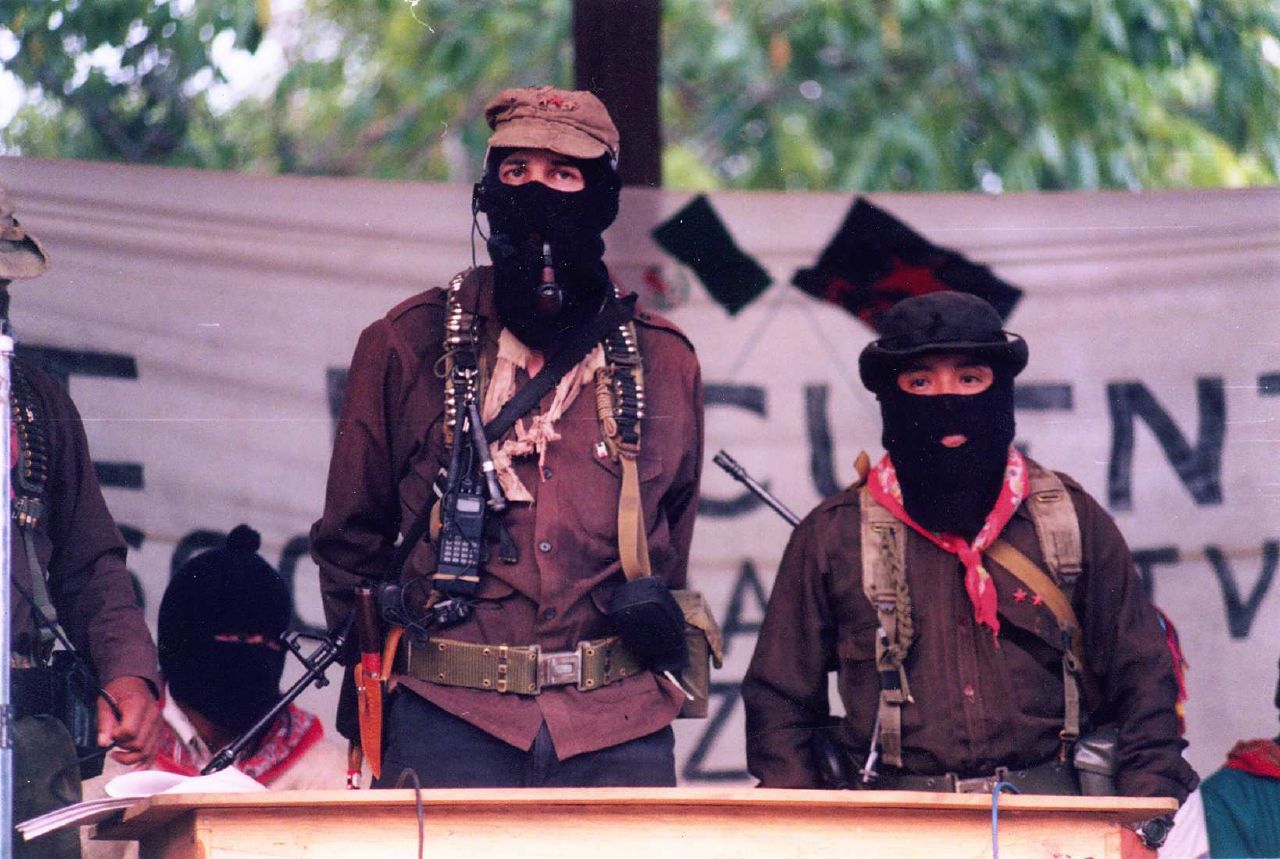 In 1994, we saw the Zapatista uprising in Mexico, with its base amongst the poor peasants of Chiapas / Image: cesar bojorquez, Flickr
In 1994, we saw the Zapatista uprising in Mexico, with its base amongst the poor peasants of Chiapas / Image: cesar bojorquez, Flickr
These were the material conditions, combined with corruption scandals, that led to a massive discrediting of all bourgeois institutions and widespread voter apathy. According to Latinbarómetro, only 25 percent of the population across the continent was “satisfied with democracy” in 2001. For the first time, the proportion of those who believe that “democracy is better than any other form of government” fell below 50 percent across the region (48 percent in 2001).
The impact of the South East Asia crisis of 1998 finally triggered a process of mass struggle and uprisings throughout the continent. Per capita GDP fell by 1.3 percent in 2001 and a further 2.3 percent in 2002.
The 21st century started in Latin America with the mass uprising of workers and peasants in Ecuador, which led to the overthrow of the hated government of Mahuad. As early as 1997, they had removed Bucaram from office when, having broken his election promises, he went on to implement an IMF-imposed austerity package. During that uprising, the question of power was posed. The masses, led by the indigenous organisations and with the backing of the workers’ unions, set up a Peoples’ Assembly and closed down the bourgeois parliament. When the government attempted to use the army, a section was won over to the side of the masses. But at the crucial moment, when the mass organisations of workers and peasants had power in their hands, their leaders did not follow through.
Similar developments took place in Bolivia, beginning with the ‘water war’ in Cochabamba in 1999-2000. In that victorious struggle, the mass of workers and peasants defied the attempts at water privatisation by means of a local uprising. A cycle of defeats and demoralisation, which had set in after the defeat of the miners in the 1980s, was thus broken. Then came the two ‘gas wars’ in February and October 2003 and in May-June 2005.
These were truly insurrectionary movements sparked around the demand for the nationalisation of gas. The mass of workers and peasants paralysed the country with road blockades and a powerful general strike. The miners marched on the capital armed with dynamite sticks. The government buildings were surrounded. Once again, the powerful COB trade union could have taken power, and even talked about it in their own statements. They failed, however, to take the situation to its logical conclusion.
At the end of 2001 we saw another uprising, this time in Argentina, which became known as the Argentinazo. Spontaneously, spurred by the economic crisis and a run on the banks, the masses came out on the streets and defied the established order. In the space of a few weeks, five governments came and went, unable to control the powerful mass movement. The question of power was posed, with the masses organising in Peoples’ Assemblies and a huge piquetero movement of the unemployed workers.
The uprising here did not go as far as previously in Ecuador and later in Bolivia, but the potential was there for a revolutionary movement to defy the power of the ruling class. Unfortunately, the organisations claiming to be ‘Trotskyist’ in Argentina failed to clearly pose the question of workers’ power. Instead, they raised only democratic slogans, like calling for a Constituent Assembly, which were clearly not applicable to a situation in which there was already a bourgeois democracy in the country.
To these insurrections we must also add the Arequipazo in Peru in 2002, a massive general strike which defeated the privatisation of electricity in Arequipa; as well as the 2006 Oaxaca commune and the mass movement against electoral fraud in Mexico in the same year.
I stress the question of these uprisings because the process is usually presented as merely the election of ‘progressive’ governments that then proceeded to carry out reforms. In fact, what we had at the time was an explosion of accumulated anger against the social and economic consequences of ultra-liberal policies (known as ‘neoliberalism’) and the discredited institutions of bourgeois democracy. The mass of workers and peasants took matters into their own hands and posed the question of power.
It was the failure of these uprisings to take power on account of the weakness of their leaderships, which then allowed the derailing of the movement towards the bourgeois electoral field, leading to the election of Nestor Kirchner (Argentina, 2003), Evo Morales (Bolivia, 2005) and Rafael Correa (Ecuador, 2006), among others. Once in power, the role these governments played was one of restoring the legitimacy of the discredited bourgeois democratic institutions, putting an end to the insurrectionary movement of the masses from below, and restoring some degree of equilibrium.
In the case of Bolivia and Ecuador, Constituent Assemblies played decisive roles in this process of restoring legitimacy to bourgeois democratic institutions. New constitutions were drafted, containing many fine and grand-sounding words, including about the ‘plurinational’ character of these countries. Despite all the progressive changes that were implemented – and reforms are always the by-product of revolution – capitalist property was left intact, and so too was imperialist domination and the oppression of indigenous people.
Venezuela
Developments in Venezuela, of course, formed part of the same general process, but they proceeded along different lines and had some specific distinguishing features. The election of Hugo Chavez in 1998 was not so much the beginning of a process as much as it was a consequence of changes in mass consciousness going back to the Caracazo uprising of 1989, when Carlos Andrés Pérez applied an IMF-imposed austerity package. Thousands were killed when this spontaneous uprising of workers, youth and the urban poor was brutally repressed by the army and police. That in turn led to splits within the army, and the emergence of a group of Bolivarian officers, led by Chavez, who opposed the repression and twice attempted to spark a military-civilian uprising in 1992.
When Chavez came to power in 1998, his programme was a limited, progressive one of putting an end to corruption, and using the country’s national wealth (mainly from oil) to carry out social programmes to benefit the poor majority. At that point, it did not even have an explicitly anti-imperialist character. That would come later, in 2004.
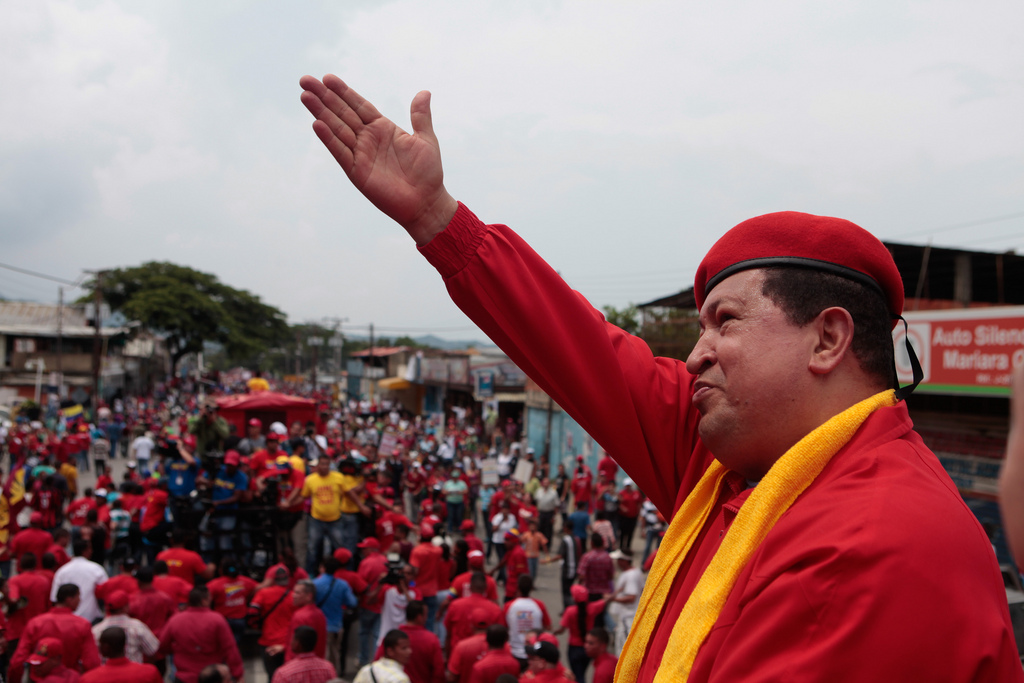 The election of Hugo Chavez in 1998 was not so much the beginning of a process as much as it was a consequence of changes in mass consciousness / Image: chavezcandanga
The election of Hugo Chavez in 1998 was not so much the beginning of a process as much as it was a consequence of changes in mass consciousness / Image: chavezcandanga
However, the attempt to actually put that limited democratic national programme into practice, particularly the agrarian reform and government control over the state-owned oil industry with the 2001 enabling laws, provoked the wrath of the capitalist oligarchy and imperialism. They decided to remove the government through a coup on 11 April 2002.
That coup was defeated through the irruption of the masses onto the scene, bringing a section of the army over to their side. This was a first in Latin American history: a military coup, organised by the capitalist oligarchy and imperialism, which was defeated by the masses on the streets. This enormously boosted the confidence of the masses in their own strength.
Through a series of blows and counter-blows, and through the active participation of the masses, the ‘Bolivarian Revolution’ as it had come to be known was propelled to the left, in an increasingly anti-capitalist direction. The experience of the masses in defeating the bosses lockout and sabotage of the economy between December 2002 and February 2003 led to a movement of factory occupations. A dynamic relationship developed between Chavez and the masses: each pushed the other to go further.
In May 2004, Chavez declared the anti-imperialist character of the revolution. In January 2005, he decreed the nationalisation of Venepal, a paper mill which had been occupied by its workers. Others followed suit, and a movement of workers’ control developed. Later on in that same month, he declared the aim of the revolution to be socialism.
The movement for workers’ control was not limited to private factories abandoned by their bosses and then nationalised, but also spread to some of the country’s main state-owned companies, like CADAFE, ALCASA, and others. With the backing of the government, a first Latin American meeting of workers in occupied factories was held in Caracas in October 2005. In 2008, the steel giant SIDOR was renationalised and put under a form of workers’ control.
Meanwhile, the peasants were occupying the big landed states with Chavez’s backing. And throughout the country, the masses had been getting organised from the very beginning of the Chavez administration.
Far from re-establishing the legitimacy of the bourgeois institutions, this process was going in the opposite direction, albeit with many contradictions: i.e. it was strengthening the direct participation of the masses in the political and economic life of the country. Chavez even raised the need to “pulverise the bourgeois state”, though this was never actually put into practice. This was what put the Venezuelan Revolution at odds with the so-called ‘progressive governments’ of Latin America.
The end of high commodity prices
The situation in Brazil also had a different character. Here we had the election of Lula in 2002, at the head of the Workers’ Party – an organisation that had been created as the political expression of the working class in the revolutionary days of the struggle against the dictatorship. His election reflected the desire of the mass of working people, the landless peasants, and the urban and rural poor in general for fundamental change. But by this time, Lula and the leadership of the PT had already abandoned their earlier claim to stand for class independence. They had substantially moderated their programme and were prepared to work within the system. From the beginning, his government was one of national unity and class collaboration.
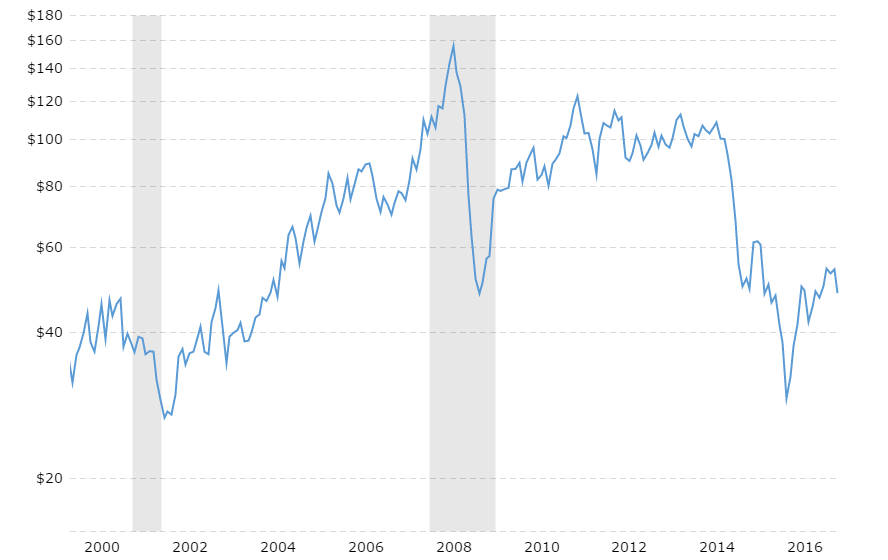 Changes in the price of oil / Image: fair use
Changes in the price of oil / Image: fair use
But despite the differences, all of these governments benefitted from a common factor: a relatively long cycle of high prices of raw materials, which lasted for the best part of a decade, ending in the commodities crash from 2014. Graphs can be produced for the price of oil, natural gas, zinc, copper, soy beans, etc., which are the main export commodities for South American countries, and they all show the same picture: a sharp increase in price starting around 2004-05, a dip in 2007-08, and then a strong recovery lasting until 2014-15.
The whole of what some bourgeois economists described as a “commodities supercycle” was largely driven by the entry of China into the world market, the development of its industry, and with it an insatiable appetite for raw materials and sources of energy. The last uptick after the world crisis of 2007 was due to the strong Keynesian measures of state spending adopted by China in the aftermath of that crisis, which had a strong impact in South America. In 2009, China became the main trading partner for the whole of the region, displacing the United States.
This cycle of high commodity prices was the basis for the stability of all these ‘progressive’ governments. It gave them certain room for manoeuvre to carry out certain social reforms without going beyond the limits of capitalism. Rising living standards and wages sustained their popularity in office.
With the exception of Venezuela, where inroads were made into capitalist property rights, all these governments remained within the limits of the system. Though some of them talked about socialism, what was meant was really social democracy, or rather the sanding down of the sharp edges of capitalism, while preserving its foundations intact. The only one to come out openly against capitalism was Hugo Chavez. But even in Venezuela, the process was never completed, a fact of which Chavez himself complained bitterly just before his death.
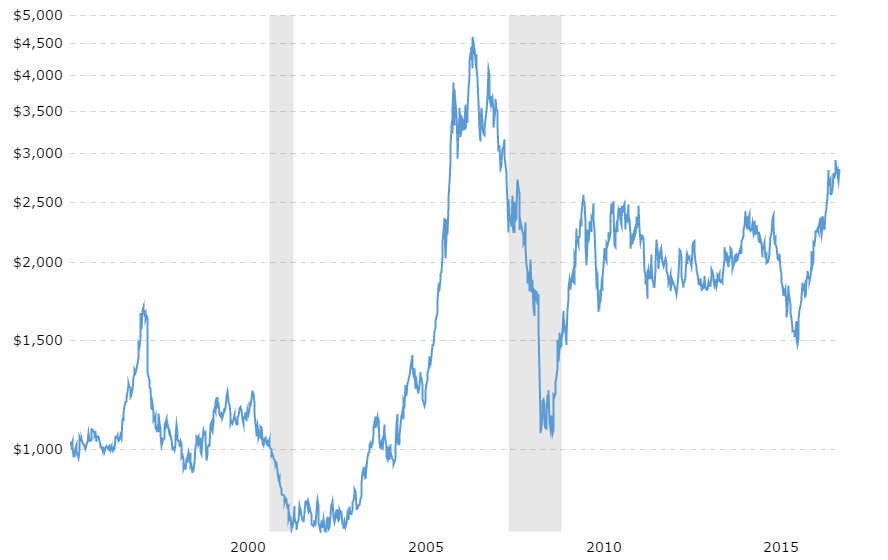 Changes in the price of Zinc / Image: fair use
Changes in the price of Zinc / Image: fair use
None of these governments fundamentally changed the character of capital accumulation in the region, based on the export of agricultural products, the looting of mineral resources and sources of energy, and the exploitation of cheap labour under the crushing domination of the world market.
There was then, as there is now, heavy emphasis on the idea of a “struggle against neoliberalism”, as if it were possible to manage capitalism in a way that would also benefit the mass of workers and peasants and not just the wealthy capitalist elites and the imperialist multinationals. In the medium and long term, that was proven to be impossible. But for a period of time, it seemed to be working.
All sorts of confused ideas were put forward, such as the idea of “socialism of the 21st century”, or Bolivia’s vice-president García Linera’s idea of “Andean-Amazonian capitalism” as a necessary stage of development before one could pose the task of socialism.
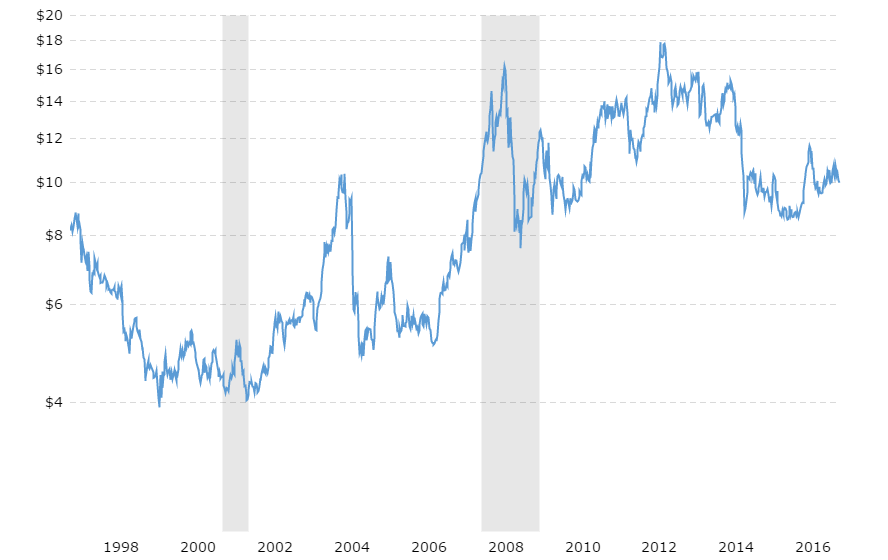 Changes in the price of soy beans / Image: fair use
Changes in the price of soy beans / Image: fair use
All these illusions came crashing down after 2014, when China’s economy sharply slowed down, bringing to an end the commodities supercycle. As night follows day, the idea that capitalism (or ‘neoliberalism’) can be tamed was revealed to be bankrupt, and all of these governments suffered election defeats or were replaced in one way or another.
In November 2015, the right winger Macri won the election in Argentina. In December 2015, Maduro’s PSUV was defeated in the National Assembly elections. In Bolivia, Evo Morales lost the constitutional referendum in February 2016. In Ecuador, Lenín Moreno, Correa’s presidential candidate, had to go to a second round of the presidential election in 2017, and then shortly afterwards broke with his mentor and aligned himself openly with imperialism and the ruling class. In Brazil, the PT candidate Dilma Rousseff, who only narrowly won in the second round of the presidential election of 2014 by shifting her campaign to the left, was then impeached in 2016 in a process started by her own bourgeois vice president Temer.
In Venezuela, formally, the PSUV remained in power, with Maduro replacing Chavez after his death in 2013. The Bolivarian Revolution was able to withstand several attempts of the imperialist backed counter-revolution to overthrow it. The revolution had gone very far, both in terms of the consciousness of the masses and in terms of the material gains they had achieved. However, even here, after the election defeat in December 2015 there was a clear process of shifting to the right. The bureaucracy entrenched itself in power; the masses were pushed back; and slowly but surely, the gains of the revolution were reversed. Workers’ control was destroyed. Land that had been expropriated under Chavez and given to the peasants was given back to the landowners (old and new). Companies which had been nationalised were reprivatised. The whole emphasis was on making peace with the ruling class – while maintaining the PSUV in power.
In 2018, the Maduro government introduced a monetarist package of anti-working class economic measures, which made the workers shoulder the weight of the economic crisis. Collective bargaining agreements were destroyed, and with them, workers’ acquired rights and conditions were also destroyed. Trade union and worker activists organising to resist these measures were thrown in jail. Very little was left of the revolutionary spirit of chavismo, and the majority of what remains of it exists in resistance to the government.
The prematurely predicted ‘death of the Left’
This led many to fall into deep pessimism, arguing that the masses in Latin America had “moved to the right”, and it was declared that a new ‘conservative wave’ had begun, which was destined to last for years. Some went as far as to argue that fascism had come to power in Brazil.
In March 2016, Mexican politician Jorge Castañeda (who went from being a member of the Communist Party to a minister in the reactionary government of Vicente Fox Quesada) published a column in The New York Times under the title, ‘The Death of the Latin American Left’. Basing himself on the electoral defeats of Kirchnerism in Argentina and of the PSUV in Venezuela, Castañeda decreed the “death” – pay attention to this: not the decline, nor the retreat, but the death – of the Latin American Left!
Nothing could have been further from the truth. What we experienced was not a significant increase in support for right-wing political parties, but what can more accurately be described as a collapse in support for the ‘progressive’ governments that had been in power and were now confronted with managing the crisis of capitalism. In fact, these developments were the result of the inability of the policies of ‘anti-neoliberalism’ to solve the fundamental problems facing the masses in these countries.
This led to confusion and demoralisation amongst a section of the masses. But the concrete material conditions pushed them once again into action. These right-wing governments were unable to carry out their policies, and faced mass opposition from the very beginning. This was the case with Macri, Bolsonaro, Lenín Moreno, etc.
Perhaps the clearest case is that of the Macri government in Argentina. When he tried to apply the attack on pensions in December 2017, he was faced by a huge wave of protests and confrontations that caused him to abandon the idea of applying labour counter-reforms. The Macri government faced five general strikes, and had it not been for the elections in October 2019, it is possible that it would have ended up being overthrown by a revolutionary uprising.
In the context of the capitalist crisis, the openly right-wing and pro-imperialist governments which replaced the ‘progressive’ governments were unable to garner any legitimacy. On the contrary, their arrival to power prepared the way for another wave of insurrectionary movements across the continent.
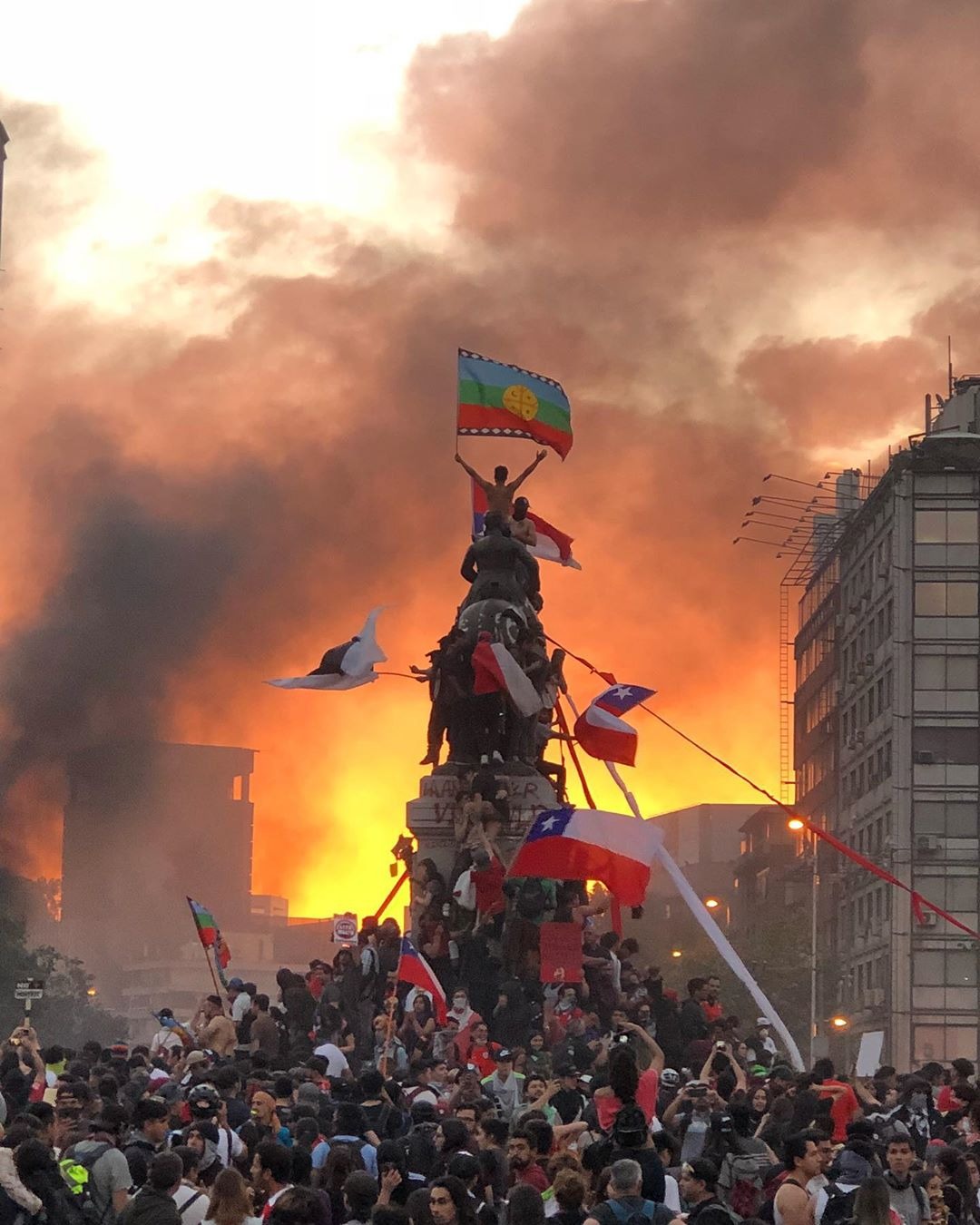 Starting in 2019, what we saw was not a ‘conservative wave’, but rather mass insurrections in country after country / Image: fair use
Starting in 2019, what we saw was not a ‘conservative wave’, but rather mass insurrections in country after country / Image: fair use
Starting in 2019, what we saw was not a ‘conservative wave’, but rather mass insurrections in country after country. In Haiti, there was a mass revolutionary movement which lasted for several months. In Puerto Rico, in July 2019, we saw mass protests that paralysed the island and forced the resignation of the governor. In Ecuador in November 2019, there was a massive insurrection against the government of Lenín Moreno that actually posed the question of power, as the government was forced to flee the capital Quito. In Chile in October to December that same year, we saw a prolonged movement that placed a question mark over the country’s entire political setup, which had been established at the end of the Pinochet dictatorship 30 years earlier.
In Colombia, we saw the massive national strike movement (paro nacional) of November 2019, and then the unprecedented national strike of April-May 2021, which put the final nail in the coffin of the Duque government and uribismo that stood behind him.
In all of these movements, to one degree or another, the question of power was posed. The mass of workers and peasants, with the revolutionary youth at the forefront, did not limit themselves in marching from A to B to oppose this or that policy. We are talking about mass demonstrations, clashes with the police that left dozens dead, the country paralysed through strikes and road blockades, the organisation of self-defence, all leading to a situation where the main slogan of the movements became the overthrow of the existing government.
What was missing in each and every case – we see this particularly clearly in Ecuador and Chile where things went further – was a revolutionary leadership fully aware of what was required: to develop the embryonic organisations of workers’ power then arising more or less spontaneously (strike committees, cabildos abiertos, peoples’ assemblies, indigenous and peoples’ guards, the Primera Linea) into a nationwide structure composed of delegates elected and recallable at any time, and for this national assembly of the working people to take power.
As this crucial factor – what Marxists describe as the ‘subjective factor’, the revolutionary leadership – was missing, the ruling class was able to defeat the movements. It did so, not by smashing them by force, although there was brutal repression as previously mentioned, but rather by bourgeois parliamentary means. This was the case in Chile, where the estallido was diverted along the safe parliamentary channel of a Constituent Convention called by the existing structures of the capitalist state. Once the masses were off the streets, the ruling class went on a counter-offensive.
In Colombia, the lack of any clear national leadership for the paro nacional of 2021 meant that the movement dissipated, and eventually the masses sought a solution instead on the electoral arena, through the election of Gustavo Petro in June 2022. In Ecuador, the election of the banker Lasso to power in 2021, by the narrowest of margins and only because of the split of the forces which had the support of workers and peasants, set the stage for a new national strike in June 2022. Nothing has been resolved.
In Bolivia, the overthrow of the Evo Morales government in 2019 was short lived. The heroic resistance of the masses did not allow the reactionary oligarchy to establish themselves firmly in power. Within a year, new elections had brought Arce, from the MAS, to the presidency.
The nature of the new ‘progressive wave’
What is being described as the ‘new progressive wave’ in Latin America is the result of this situation. These are varied governments, each with its own features.
Boric in Chile is perhaps the most right-wing of them all. Starting from the position of the postmodernist ‘left’, obsessed by questions of identity as opposed to class, and by symbols rather than material conditions, Boric has very rapidly moved to the right. A government which promised self-determination for the Mapuche people, has ended up militarising the Wallmapu and jailing the leaders of the radical Mapuche organisations.
A government which came to power promising a thorough reform of the hated carabineros police force, has ended up passing a law which enshrines impunity for the cops when using weapons against civilians. From the beginning, Boric was outspoken in his support for the general interests of US imperialism in the region and internationally (attacking Venezuela in particular).
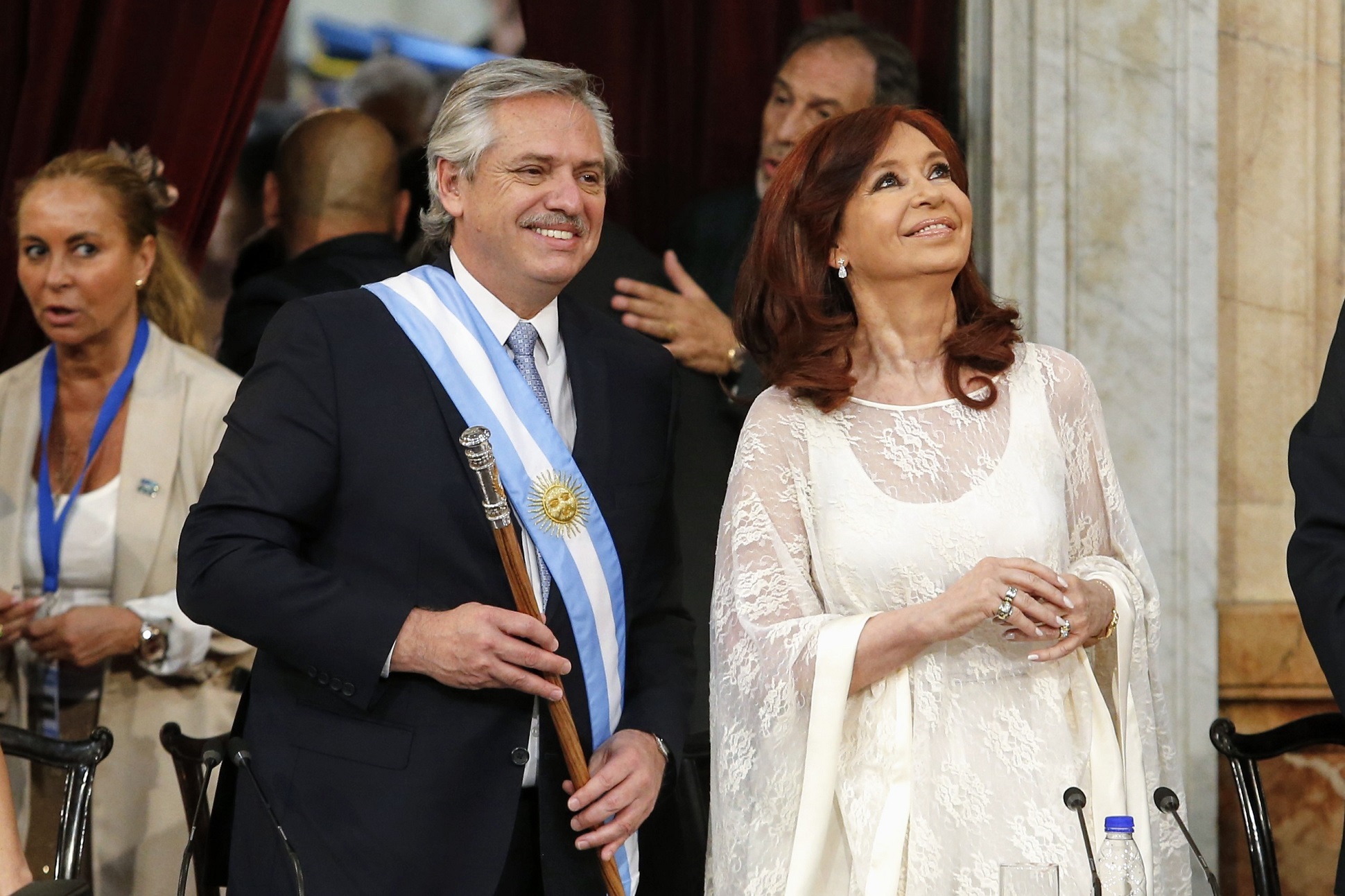 Alberto Fernandez represents a wing which looks more towards the ruling class, while Cristina Fernandez represents kirchnerism / Image: Nicolás Aboaf, Wikimedia Commons
Alberto Fernandez represents a wing which looks more towards the ruling class, while Cristina Fernandez represents kirchnerism / Image: Nicolás Aboaf, Wikimedia Commons
In Argentina, we have a government that is an unstable coalition between two wings of the historic peronist movement. Alberto Fernandez represents a wing which looks more towards the ruling class, while Cristina Fernandez represents kirchnerism, which claims to be a “national popular” current, and has deeper roots amongst the working class and the poor. But at the end of the day, faced with a deep economic crisis, a flight of capital, high inflation, and the threat of a debt default, this government has agreed to a deal with the IMF which binds it to a policy of fiscal austerity (that is, to make the workers shoulder the burden of capitalist crisis). Despite protestations and demagogic gestures, the kirchneristas are co-responsible for this anti-working class policy.
Lula’s government in Brazil starts where Dilma’s ended in terms of his right-wing shift. This is, again, a government of class collaboration and national unity. The choice of running mate was not accidental: Alckmin is one of the main political representatives of the ruling class. But in coming to power, Lula has made all sorts of agreements with bourgeois parties in Congress and the Senate, and his own Cabinet even includes Bolsonaristas.
Mexico
López Obrador, elected in 2018 in Mexico, offers a very clear example of the dominant ideas behind these governments. He has argued that the problems facing Mexico are due to corruption, bureaucracy and mismanagement. And he has railed against neoliberalism and advocated the development of national capitalism. Since coming to power, he has consistently implemented his programme, which remains within the limits of capitalism, by cutting the wages of high ranking officials, fighting tax evasion and generally attempting to implement a more frugal approach to the state bureaucracy.
On the surface, his programme seems to be working. He has implemented a wide range of social programmes aimed at the poorest layers in society, as well as undertaking a series of high profile infrastructure projects. But in reality, his government has benefitted from a particular combination of economic factors that cannot really last: high oil prices; foreign investment by US companies bringing back some of their production from China in the aftermath of the COVID-19 shock on supply lines; and, as a result of this, a strong peso.
Unlike countries in South America that are more closely linked to the Chinese economy, Mexico is very much dominated by its powerful neighbour to the north. As soon as the recession starts in the United States, the Mexican economy will be hard hit, and the attempt to implement limited reforms and a programme of national development within the limits of capitalism will be shown for what it is: a pipe dream.
In the case of Mexico too, the López Obrador government has worked to re-establish the legitimacy of bourgeois institutions tarnished by decades of corrupt governments, election fraud and state repression.
Peru
The case of Peru is worth studying in detail. Here the election of Pedro Castillo in July 2021, as the candidate of Peru Libre, was a major turning point. It represented the aspiration of the masses to break with the past, with the legacy of the Fujimori dictatorship, its ultra-liberal policies, and 20 years in which all elected presidents had betrayed them.
Although Peru Libre calls itself a Marxist, Leninist and Mariateguist party, its policies are in fact a rehash of the old two stages policy of Stalinism. The party programme talks about a “popular economy with markets”, in which the power of the multinationals is reigned in and “productive businesses” are encouraged. Castillo himself, whilst not a party member, campaigned under the slogan of “never again, poor people in a rich country”, promising to renegotiate the contracts with mining multinationals (and if they refused, to expropriate them), to nationalise gas, and to use the proceeds to provide education, healthcare, housing, and jobs for all.
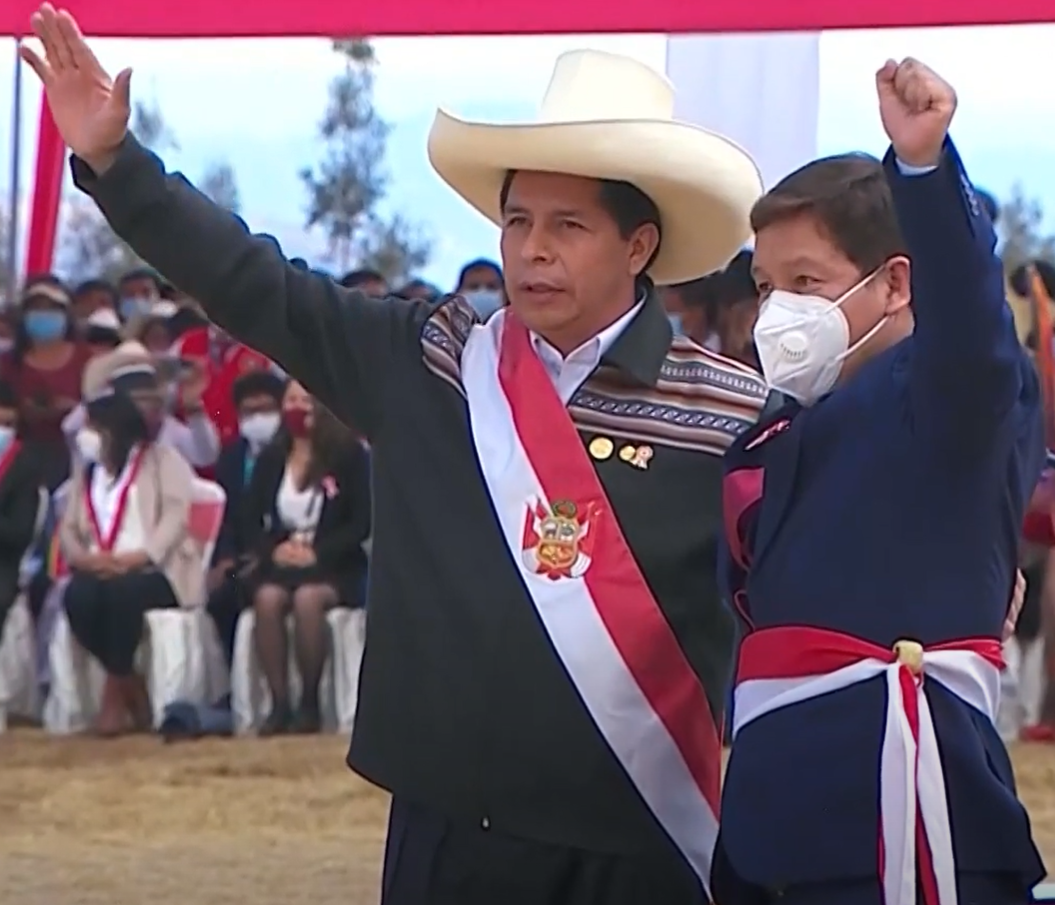
This programme, limited as it was, clashed head on with the interests of the capitalist oligarchy and those of the powerful mining multinationals (from Canada, the US, China and Britain), backed by imperialism. From the first day of his presidency, Castillo came under enormous pressure, was subjected to a campaign of demonisation on the part of the highly concentrated capitalist media of Peru, and faced constant sabotage from Congress, dominated by the oligarchy. He then proceeded to make concessions (removing the foreign affairs minister, then the premier, then the minister of labour), and to water down his programme (regarding the mining and gas multinationals).
Far from appeasing the ruling class, however, his concessions were seen as a sign of weakness and invited even more aggression, while weakening his support amongst the workers, peasants and the poor. Finally, in December 2022, barely 16 months into his term of office, the capitalist oligarchy (having been given the go ahead by the US embassy) carried out a coup and threw Castillo into jail.
The response of the masses was heroic and exemplary. For two months, they occupied the streets, organised mass strikes, and marched on the capital Lima, defying the brutal repression of the Boluarte regime, which used police and the army against unarmed demonstrators, killing over 60 (itself a conservative count).
The main lesson of the Castillo government is that even a mild, limited programme of reforms will put anyone attempting to carry them out (and Castillo retreated from his own programme from day one) on a collision course with the ruling class and imperialism. They will not hesitate to use all means at their disposal (the media, social networks, bourgeois public opinion, the judiciary, the state apparatus, and ultimately the police and the army) to undermine such a government and eventually, if necessary, to overthrow it. Despite his moderation, Petro in Colombia is facing precisely such a campaign too.
The attitude of the capitalist oligarchy and imperialism
The attitude of the ruling class and imperialism towards the governments in these countries is mixed. On the one hand, capitalists want ‘stability to conduct business’ (that is, to exploit the workers and peasants). To the degree that these governments are able to provide it, they take a pragmatic view and are prepared to tolerate them.
On the other hand, these governments have, to one degree or another, been propelled to power by the aspirations of the masses of workers and peasants for a better life. Despite their moderate programmes, the particularly reactionary ruling capitalist oligarchy in Latin America cannot allow any challenge to their power, wealth and privilege, however limited this may be (God forbid they should be asked to pay taxes, for instance!)
Politicians like Gustavo Petro in Colombia, therefore, whilst not exactly being a revolutionary hot head, are facing a constant campaign of demonisation in the media, and are being undermined through plotting by sections of the state apparatus, and in some cases through attempts to mobilise layers of the middle class against them. We have seen similar developments in Mexico. Petro, López Obrador and others are accused of being “Castro-chavistas”, communists or worse. If only! In his victory speech after winning the election in Colombia, Gustavo Petro openly said, “we will develop capitalism.” During his election campaign, he even signed a legally binding document committing himself not to carry through any expropriations.
The problem is that in the period of capitalism’s senile decay, in countries which are under the domination of imperialism, it is impossible to carry out any kind of national development, nor to satisfy the pressing needs of the masses for housing, jobs, education, healthcare and pensions, without making inroads into the property of the landowners, bankers, capitalists and multinationals. As shown in Peru, even the demand to renegotiate mining contracts to increase taxes and royalties is anathema to the bloodsucking vampires in the mining multinationals.
If these governments are, for a period of time, too strong to be overthrown, the capitalists are prepared to accept the situation and bide their time, while at the same time using all the means at their disposal to undermine them. Once they have been discredited and no longer serve the useful purpose of lulling the masses into passivity, then they are discarded, by whatever means necessary.
Obviously, behind the backward local oligarchy – a particularly despicable ruling class, permeated with a deep hatred and fear of the masses, combined with deep-seated racism – stands US imperialism, which has always considered the continent as its backyard. Ever since the proclamation of the Monroe doctrine in 1823 (“America for the Americans”), Washington has arrogated the right to remove and overthrow governments that are not of their liking. As the criminal Henry Kissinger once said, “I don't see why we need to stand by and watch a country go communist due to the irresponsibility of its people. The issues are much too important for the Chilean voters to be left to decide for themselves.” That sums up the real attitude of US imperialism towards bourgeois democracy.
It has become fashionable in progressive circles in Latin America to talk about ‘lawfare’, that is, the practice of using the judiciary to undermine and remove ‘progressive governments’. This could be seen for instance in the Lava Jato investigation in Brazil, a politically motivated operation to destroy the PT and demoralise the working class, using corruption as a convenient battering ram.
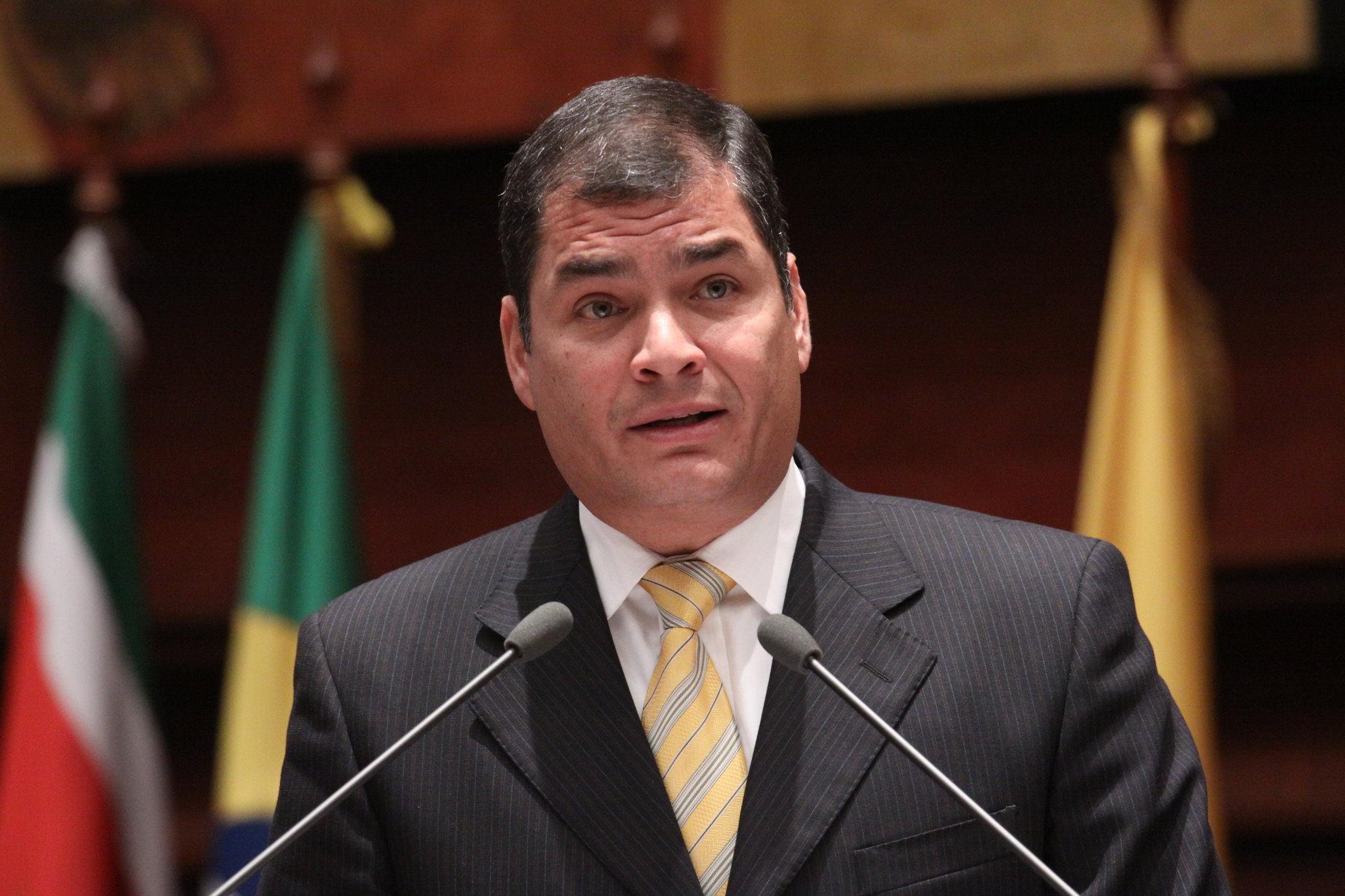 Judicial proceedings have also been used against Ecuador’s Rafael Correa / Image: Asamblea Nacional del Ecuador, Flickr
Judicial proceedings have also been used against Ecuador’s Rafael Correa / Image: Asamblea Nacional del Ecuador, Flickr
The investigation broke all rules of bourgeois legality. That did not matter. The main aim was achieved: Lula was prevented from standing (and jailed), the PT was thoroughly discredited, and judge Moro became a minister in Bolsonaro’s government. Similar methods had been used in 2016 to bring about the impeachment of Dilma Rousseff, Lula’s successor as country’s president for the PT.
We now see a similar development in Argentina where the judiciary has taken measures to bar Cristina Kirchner from standing in the election. The aim, again, is clear: to remove a politician who, despite her bourgeois programme, retains links with the masses and sometimes uses demagogic language against the IMF, which can become dangerous. Judicial proceedings have also been used against Ecuador’s Rafael Correa and others.
But, can this be described as ‘lawfare’ involving misuse of the judiciary? And is this really a new phenomenon? One can only draw the former conclusion if we assume that the judiciary is an independent and impartial body. In reality, there is no such thing as a ‘rule of law’, standing above and outside the interests of the ruling class. Justice in a bourgeois society has always been class justice, to the benefit of the capitalists.
Of course, in order for this fiction to work, in most cases rules are followed. But the ruling class has never shied away from bending or breaking its own rules altogether if necessary to defend their wealth and property. There is nothing new in ‘lawfare’ then. And the more open class-based use of the judiciary to uphold the interests of the rotten capitalist oligarchy should be used, not to demand a genuinely ‘fair’ justice system, which cannot exist in a class-divided society, but rather to expose the real character of the so-called ‘rule of law’.
The first and second ‘progressive waves’
The character of these governments – which taken as a whole are much weaker, meeker and overall more reactionary in their policies than those of the preceding ‘progressive wave’ – is determined by the fact that they cannot count even on the limited room for manoeuvre that the first wave enjoyed in 2005-15. The economic situation in Latin America is one of dire capitalist crisis. The region was the worst affected in the world by the pandemic, both in terms of the death toll and in terms of the socio-economic impact. In the ten years to 2023, the region’s GDP has grown at an average of 0.8 percent, which if you take into account population growth means a decline, rather than stagnation. By way of comparison, during the lost decade of the 1980s, average growth was 2 percent.
Commenting on these figures, José Manuel Salazar-Xirinachs, the head of the UN Economic Commission on Latin America and the Caribbean (CEPAL), said, “This is terrible, this really ought to be a huge red light.”
Rather than a ‘supercycle’ of high commodity prices like that which the previous wave of ‘progressive governments’ enjoyed, we now face a period of global capitalist crisis, aggravated by the sharp slowdown of the Chinese economy, the retreat from globalisation, etc. The countries of Latin America, completely integrated into and dependent on the world market, will suffer particular pain.
This is not to say that there cannot be temporary counter-currents. There is currently high demand for certain minerals related to the transition to electric vehicles (lithium); some countries have benefitted from high energy prices driven partially by the war in Ukraine and sanctions on Russia; Mexico has received investment from US companies ‘near-shoring’ their production away from China. All these factors are limited in their impact and limited in time. The worldwide recession which is coming will provoke a sharp contraction in the demand for raw materials, minerals and sources of energy, on which the Latin American economies depend.
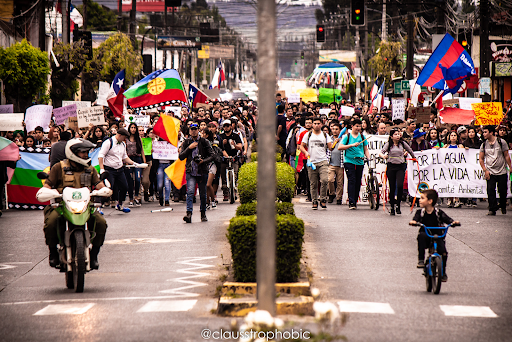 Workers and peasants will be spurred into action in an attempt to defend their living conditions and reverse the attacks / Image: fair use
Workers and peasants will be spurred into action in an attempt to defend their living conditions and reverse the attacks / Image: fair use
This new ‘pink tide’ or ‘wave of progressive governments’ – whatever we choose to call them – will certainly not be stronger than the first one. Quite the contrary. From the beginning, it will be faced with a serious crisis of capitalism and will be forced to implement anti-working class measures. The masses will not remain passive. A government elected by the masses, and in which the latter have invested illusions of change, can of course provoke a certain period of disillusionment or demoralisation when it carries out policies in favour of the ruling class. But as inevitably as night follows day, workers and peasants will be spurred into action in an attempt to defend their living conditions and reverse the attacks.
In other words, even the national and democratic tasks of the revolution that are pending to different degrees in different Latin American countries, can only be fully realised by the overthrow of capitalism and the coming to power of the working class at the head of all the oppressed layers of society. Within the limits of capitalism, none of these problems can be resolved. This conclusion, which can be drawn in practice from the experience of the last few decades and even of the two centuries since the Latin American nations achieved independence, is the same as that formulated by Trotsky in his theory of the permanent revolution.
This was the policy of the early Leninist Communist International with respect to Latin America. The same policy was formulated by Latin American communists like the Peruvian Jose Carlos Mariátegui, and the Cuban Julio Antonio Mella in the 1920s. Only the socialist revolution can begin to address the problems of backwardness, national oppression, agrarian reform, housing, jobs, education and healthcare facing millions of working-class and poor people across this wealthy continent. This means the expropriation of the tiny and rotten capitalist oligarchy of landowners, industrialists and bankers, which are tied by a thousand threads to the domination of imperialism.
The perspective for Latin America, as it is for the world as a whole, is one of turmoil and stress, of big battles and revolutionary upheavals. Time and again, the question of power will be posed. The most urgent task for revolutionaries across the continent is to draw the necessary lessons from the last 25 years in order to prepare for the battles ahead.
Capitalism, in its epoch of senile decay, cannot be managed ‘better’, nor in a way that benefits the mass of working people. The struggle is not against neoliberalism, but rather is for the overthrow of the capitalist system as a whole. We have full confidence in the ability of the working class to transform society and take the future into its own hands. We urgently need to build the revolutionary leadership needed to take the struggle to victory.

